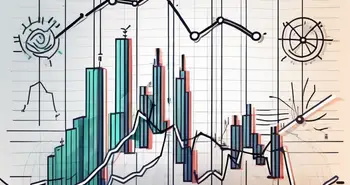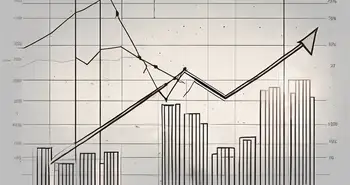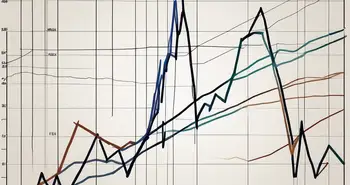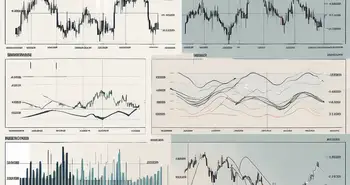Understanding Price Action in Forex: A Comprehensive Guide

In the fast-paced world of forex trading, understanding price action is crucial to success. As an experienced trader, I have discovered that price action is the language of the market. It provides valuable insights into the behavior of currency pairs and can help predict future price movements.
The Basics of Price Action in Forex Trading
Before delving into the depths of price action, it is important to establish a clear definition. Price action refers to the movement of a currency pair's price on a chart over time. It takes into account the highs, lows, and everything in between. By analyzing this data, traders can identify patterns, trends, and potential trading opportunities.
Understanding the importance of price action is paramount. It allows traders to make informed decisions based on actual market activity. Rather than relying solely on indicators or news releases, price action provides a real-time snapshot of market sentiment.
There are key components to consider when studying price action. These include support and resistance levels, trend lines, and chart patterns. These elements help identify areas of potential buying or selling pressure, allowing traders to plan their trades accordingly.
Support and resistance levels are crucial in price action analysis. Support represents a price level where buying pressure is strong enough to prevent the price from falling further. It acts as a floor, supporting the price and potentially causing it to reverse direction. Resistance, on the other hand, is a price level where selling pressure is strong enough to prevent the price from rising further. It acts as a ceiling, capping the price and potentially causing it to reverse direction.
Trend lines are another important tool in price action analysis. They are drawn on a chart to connect consecutive highs or lows, creating a visual representation of the trend. An uptrend is characterized by a series of higher highs and higher lows, indicating bullish momentum. A downtrend, on the other hand, is characterized by a series of lower highs and lower lows, indicating bearish momentum. Trend lines help traders identify the direction of the market and potential areas of support or resistance.
Chart patterns are also significant in price action analysis. These patterns are formed by the price movement on a chart and can provide valuable insights into future price behavior. Some common chart patterns include triangles, rectangles, and head and shoulders. Traders use these patterns to anticipate potential breakouts or reversals, allowing them to enter or exit trades at favorable prices.
By combining support and resistance levels, trend lines, and chart patterns, traders can develop a comprehensive understanding of price action. This knowledge enables them to make well-informed trading decisions, based on the actual behavior of the market. It allows them to identify high-probability setups and manage risk effectively.
In conclusion, price action analysis is a powerful tool in forex trading. It provides traders with valuable insights into market sentiment and helps them identify potential trading opportunities. By studying support and resistance levels, trend lines, and chart patterns, traders can develop a comprehensive understanding of price action and make informed trading decisions.
Reading Forex Price Action Charts
Forex price action charts are the visual representation of currency pair movements. They provide traders with valuable insights into market trends and potential trading opportunities. Understanding how to interpret these charts is essential for successful trading in the forex market.
There are several types of charts commonly used by traders, including line charts, bar charts, and candlestick charts. Each chart type presents price data in a unique way, allowing traders to analyze and interpret market movements from different perspectives.
Line charts are the simplest form of forex price action charts. They plot the closing prices of currency pairs over a specific period of time, connecting them with a line. Line charts provide a clear overview of the general price trend but lack detailed information about price fluctuations within each time period.
Bar charts, on the other hand, provide more detailed information about price movements. They display the opening, closing, high, and low prices for each time period as vertical bars. The length of the bar represents the price range, while the horizontal lines on each side indicate the opening and closing prices. Bar charts allow traders to analyze price volatility and identify key support and resistance levels.
Candlestick charts are widely used by forex traders due to their ability to convey a wealth of information in a visually appealing way. Each candlestick represents a specific time period and displays the opening, closing, high, and low prices. The body of the candlestick is filled or hollow, depending on whether the closing price is higher or lower than the opening price. Candlestick patterns, such as bullish or bearish engulfing patterns, doji formations, and double tops or bottoms, can provide valuable insights into potential reversals or continuation of trends.
Interpreting price movements on forex price action charts requires careful analysis. Traders look for patterns and formations that can signal potential trading opportunities. For example, a bullish engulfing pattern occurs when a small bearish candle is followed by a larger bullish candle, indicating a potential reversal from a downtrend to an uptrend. Conversely, a bearish engulfing pattern suggests a potential reversal from an uptrend to a downtrend.
Doji formations are another important candlestick pattern to watch for. A doji occurs when the opening and closing prices are very close or equal, resulting in a small or nonexistent body. This pattern indicates indecision in the market and can signal a potential trend reversal.
In addition to patterns, identifying trends is a crucial aspect of reading forex price action charts. Trends can be classified as uptrends, downtrends, or sideways trends. An uptrend is characterized by a series of higher highs and higher lows, indicating a bullish market sentiment. Conversely, a downtrend consists of lower highs and lower lows, signaling a bearish market sentiment. Sideways trends, also known as consolidation or ranging markets, occur when prices move within a relatively narrow range without a clear direction.
By recognizing the direction of the trend, traders can align their trades with the prevailing market sentiment. For example, in an uptrend, traders may look for buying opportunities near support levels or on pullbacks, while in a downtrend, they may seek selling opportunities near resistance levels or on rallies.
In conclusion, forex price action charts provide traders with a visual representation of currency pair movements. By analyzing these charts and identifying patterns and trends, traders can make informed trading decisions and increase their chances of success in the forex market.
Strategies for Price Action Trading
Developing a price action trading plan is essential for consistent profitability. A well-defined plan includes entry and exit criteria, risk management guidelines, and trade management strategies.
Risk management is a key component of price action trading. Managing risk allows traders to protect their capital and ensure longevity in the markets. By implementing appropriate stop-loss orders and position sizing techniques, traders can limit potential losses and maximize potential gains.
Avoiding common price action trading mistakes is crucial to success. Traders often fall into the trap of overtrading, chasing trades, or failing to adapt to changing market conditions. By being aware of these pitfalls, traders can make more informed and disciplined trading decisions.
Advanced Concepts in Price Action Trading
Understanding market context is an advanced concept in price action trading. It involves analyzing broader market factors, such as economic data, geopolitical events, and central bank announcements, to better understand price action movements. By considering these external factors, traders can gain a deeper understanding of the market dynamics.
Volume plays a significant role in price action trading. It provides insights into the strength of buying or selling pressure. Analysing volume alongside price action can confirm or challenge market trends, offering valuable confirmation for traders.
Market psychology is another crucial aspect of price action trading. Understanding the emotions and behaviors of market participants can help anticipate potential market movements. Fear and greed often drive market sentiment, and as a trader, being aware of these emotions can give you an edge in the markets.
As an expert in price action trading, I have experienced the power and potential profitability of this trading approach. However, it is important to remember that there is no holy grail in trading. It requires dedication, discipline, and continuous learning to master the art of price action.
FAQ
What is price action in forex trading?
Price action in forex trading refers to the movement of a currency pair's price on a chart over time. It involves analyzing the highs, lows, and other price levels to identify patterns, trends, and potential trading opportunities.
How can I read forex price action charts effectively?
To read forex price action charts effectively, you need to analyze patterns, such as engulfing patterns, doji formations, or double tops or bottoms. Identifying trends is also crucial. Using different types of charts, such as candlestick charts, can help you interpret price movements accurately.
What are the key components of price action trading?
The key components of price action trading include support and resistance levels, trend lines, and chart patterns. These elements help identify potential buying or selling pressure and assist in making informed trading decisions.
How important is risk management in price action trading?
Risk management is vital in price action trading. It involves implementing stop-loss orders and position sizing techniques to protect capital and minimize potential losses. By managing risk effectively, traders can ensure longevity in the markets.
What are common price action trading mistakes to avoid?
Some common price action trading mistakes to avoid include overtrading, chasing trades, and failing to adapt to changing market conditions. By being aware of these pitfalls, traders can make more disciplined and informed trading decisions.
Is price action trading suitable for beginner traders?
Price action trading can be challenging for beginner traders. It requires a deep understanding of market dynamics, patience, and continuous learning. However, with dedication and practice, beginners can develop the necessary skills to succeed in price action trading.
In conclusion, understanding price action in forex is a comprehensive guide that can propel your trading career to new heights. By mastering the basics, reading forex price action charts, and implementing effective price action trading strategies, you can gain a competitive edge in the markets. Remember to constantly refine your skills, manage risk, and stay disciplined. Happy trading!
Ready to take your forex trading to the next level with the insights from price action? Discover the future of trading with Morpher, the innovative platform that offers zero fees, infinite liquidity, and the flexibility of fractional investing. Whether you're a seasoned trader or just starting out, Morpher's unique trading experience on the Ethereum Blockchain, complete with up to 10x leverage, is designed to enhance your trading strategy. Sign Up and Get Your Free Sign Up Bonus today to join the revolution in trading across stocks, cryptocurrencies, forex, and more with Morpher.

Disclaimer: All investments involve risk, and the past performance of a security, industry, sector, market, financial product, trading strategy, or individual’s trading does not guarantee future results or returns. Investors are fully responsible for any investment decisions they make. Such decisions should be based solely on an evaluation of their financial circumstances, investment objectives, risk tolerance, and liquidity needs. This post does not constitute investment advice.

Painless trading for everyone
Hundreds of markets all in one place - Apple, Bitcoin, Gold, Watches, NFTs, Sneakers and so much more.

Painless trading for everyone
Hundreds of markets all in one place - Apple, Bitcoin, Gold, Watches, NFTs, Sneakers and so much more.








